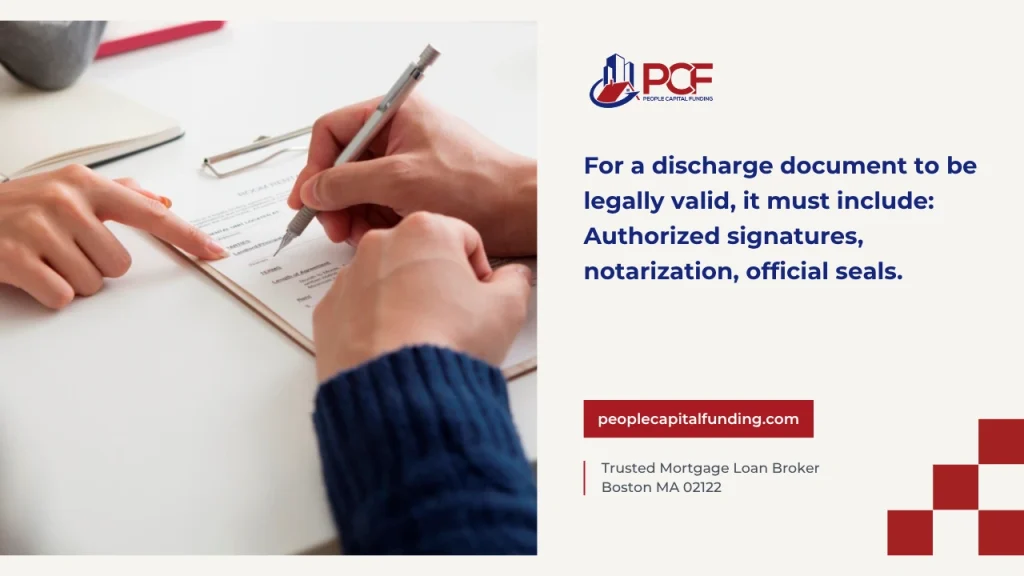
A discharge of mortgage is the legal document that officially releases you from your mortgage debt obligations after you’ve paid off your loan. This critical document transfers the clear title of your property from the lender back to you, confirming you now fully own your home without any claims from the mortgage company.
For homeowners, this document represents the culmination of years of payments and financial commitment. In this comprehensive guide, we’ll walk through everything you need to know about mortgage discharges – from what they contain and when you’ll receive one to why they matter for your property rights and financial future.

Discharge of Mortgage – Detailed Explanation
Legal Definition and Purpose
A discharge of mortgage serves as the official legal instrument that confirms you’ve satisfied all obligations under your mortgage agreement. This document does three important things:
- It formally acknowledges that you’ve paid your mortgage debt in full
- It releases the lien that the lender placed on your property
- It transfers full and clear title of the property to you as the homeowner
What many homeowners don’t realize is that simply making your final mortgage payment doesn’t automatically give you complete ownership of your property. The discharge document is what actually removes the lender’s legal claim to your home. Without this document properly filed, the lender technically still has a legal interest in your property, even if you’ve paid every cent you owed.
Think of it this way: when you first took out your mortgage, your lender recorded a lien against your property at the county records office. This lien needs to be officially removed through the recording of a discharge document. Only then is the property truly and legally yours free and clear.
Alternative Names and Terminology
Depending on your location in the United States, you might hear this document called by several different names:
- Satisfaction of mortgage
- Release of mortgage
- Mortgage release certificate
- Certificate of discharge
- Mortgage satisfaction piece (common in Pennsylvania)
- Release deed (used in some New England states)
- Reconveyance deed (primarily in California and some western states)
These terms all refer to essentially the same legal document, though there may be slight variations in format and specific requirements depending on your state’s laws. Regardless of what it’s called in your area, the purpose remains the same: to officially document that your mortgage has been paid in full and remove the lender’s claim to your property.

When Do You Receive a Discharge of Mortgage?
Upon Full Loan Payoff
You’ll receive a mortgage discharge document in several common scenarios:
- Regular Payoff at End of Term: If you’ve made all scheduled payments over the life of your loan (typically 15 or 30 years), you’ll receive a discharge once your final payment clears.
- Early Payoff: Many homeowners make extra payments to pay off their mortgage ahead of schedule. Whether you’ve been making additional principal payments consistently or paid off a large chunk at once, you’ll get your discharge when the loan balance reaches zero.
- Refinancing: When you refinance your home, you’re essentially paying off your existing mortgage with a new loan. In this case, the old loan will be discharged as part of the refinancing process. Keep in mind that you’ll now have a new mortgage lien on your property under the terms of your refinance loan.
- Home Sale: If you sell your home while still carrying a mortgage, the proceeds from the sale typically go toward paying off your remaining loan balance. Once the loan is paid in full from these proceeds, a discharge will be issued.
Timeline for Receiving the Document
The timeline for receiving your mortgage discharge varies by state and lender, but you can generally expect:
| State | Typical Processing Time | Maximum Legal Deadline |
|---|---|---|
| California | 30 days | 30 days |
| Florida | 45-60 days | 60 days |
| New York | 30-45 days | 45 days |
| Texas | 30-45 days | 60 days |
| Illinois | 30 days | 30 days |
Most states require lenders to prepare and file the discharge document within 30-60 days after you’ve paid off your mortgage. However, actual processing times can vary based on your lender’s efficiency, county recording backlogs, and other factors.
If your discharge is delayed beyond the legal deadline in your state, you should:
- Contact your lender directly and request an update
- Send a written request for the discharge document via certified mail
- File a complaint with your state’s banking department or consumer protection agency if necessary
- Consider consulting with a real estate attorney if significant delays continue
In some cases, lenders may be subject to penalties for failing to provide timely discharges, which can help motivate them to resolve the issue quickly.
Key Components of a Discharge Document
Essential Information Included
A properly executed discharge of mortgage document typically contains the following key information:
- Borrower details: Your full legal name and possibly your address
- Lender information: The name of your mortgage company or bank
- Property description: The legal description of your property, including lot number, block, subdivision, and county
- Mortgage details: Recording information for the original mortgage, including the date it was recorded and document number
- Satisfaction statement: Clear language stating that the mortgage has been “paid in full,” “satisfied,” or “discharged”
- Discharge date: The date when the mortgage was officially satisfied
The document serves as proof that the specific mortgage identified in the record has been completely paid off. This information will be crucial if you ever need to prove you own your property free and clear of this particular lien.
Required Signatures and Notarization
For a discharge document to be legally valid, it must include:
- Authorized signatures: The document must be signed by an authorized representative of your lender, such as a vice president, loan officer, or other designated official
- Notarization: Most states require that the lender’s signature be notarized by a licensed notary public
- Official seals: In addition to notarization, some discharge documents include corporate seals or stamps from the lending institution
These authentication elements help prevent fraud and ensure the document will be accepted for recording at your county’s property records office. Without proper signatures and notarization, the discharge might be rejected, potentially leaving the lien on your property.

The Legal Importance of Mortgage Discharge
Property Ownership Protection
The discharge of mortgage document provides several crucial forms of protection for your property rights:
- Clear title establishment: The discharge removes the lender’s claim from your property’s title, giving you clear ownership. This “clean” title history is essential for any future transactions involving your property.
- Protection against future claims: Without a properly recorded discharge, a lender could potentially make future claims against your property, even if you’ve paid the loan in full. The discharge serves as your definitive proof that the debt has been satisfied.
- Impact on property value and marketability: A property with clear title (confirmed by a properly recorded discharge) is typically more valuable and easier to sell than one with unresolved liens or title issues.
If you ever need to prove your ownership in the future, perhaps decades later when records may be harder to locate, having your discharge document properly recorded provides a permanent public record of your clear title.
Credit and Financial Benefits
Beyond protecting your property rights, a mortgage discharge offers several financial advantages:
- Credit report updates: Once your mortgage is discharged, your credit report should be updated to show the account as “paid in full” or “closed.” This can positively impact your credit history by showing you successfully paid off a major loan.
- Debt-to-income ratio improvements: With your mortgage paid off, your monthly expenses decrease significantly, improving your debt-to-income ratio. This can make it easier to qualify for other loans if needed.
- Financial planning advantages: Without a mortgage payment, you’ll have more financial flexibility. Many homeowners redirect their former mortgage payment amount toward retirement savings, other investments, or building an emergency fund.
Some homeowners notice their credit scores temporarily dip after paying off a mortgage because they lose the benefit of ongoing positive payment history. However, this effect is usually minor and short-lived compared to the financial benefits of eliminating mortgage debt.

How to Obtain Your Discharge of Mortgage
Automatic Process vs. Manual Request
In most cases, the discharge process begins automatically when you pay off your mortgage, but there are important differences to understand:
Lender’s standard procedures: Most lenders will initiate the discharge process as soon as they receive and process your final payment. They’re legally required to do this in most states.
When borrowers need to take action: You may need to request your discharge document if:
- You haven’t received it within the timeframe required by your state
- You’re paying off an older mortgage with a lender that’s no longer in business
- The loan was sold multiple times and the current servicer doesn’t have complete records
- You’re trying to clear an old lien that should have been discharged years ago
Documentation requirements: If you need to request a discharge, you’ll typically need to provide proof that the loan was paid in full, such as a zero-balance statement, payment history, or other documentation from the lender.
Steps to Request Your Discharge
If your discharge isn’t automatically processed, follow these steps:
- Contact your lender: Call your mortgage servicer’s customer service department and request information about your discharge document. Ask for specific details about their process and timeline.
- Submit a written request: Follow up with a formal written request that includes:
- Your name and contact information
- Property address
- Loan account number
- Date the loan was paid in full
- A clear statement requesting the preparation and recording of your discharge document
- Pay any required fees: Some states allow lenders to charge a small fee for preparing and recording discharge documents. These fees typically range from $30 to $150 depending on your location and lender policies.
- Follow up regularly: If you don’t receive confirmation within 30 days, contact your lender again. Document all communications, including the names of representatives you speak with and summaries of the conversations.
- Verify recording: Once the lender confirms they’ve sent the discharge for recording, follow up with your county recorder’s office to verify it was actually recorded. Request a copy of the recorded document for your permanent records.
If your lender is unresponsive or refuses to provide the discharge, you may need to escalate by filing complaints with:
- Your state’s banking department
- The Consumer Financial Protection Bureau (CFPB)
- Your state attorney general’s office
What to Do After Receiving Your Discharge
Once you receive your discharge document, take these important steps:
- Review for accuracy: Check that all information on the document is correct, including your name, property description, and mortgage details.
- Keep it safe: Store the original document in a secure location like a safe deposit box or fireproof home safe. This is an important legal document you may need in the future.
- Make copies: Create digital and physical copies as backups, and store them separately from the original.
- Verify county recording: Check with your county recorder’s office to confirm the discharge was properly recorded in the public record. Request a certified copy of the recorded document for your files.
- Update your records: Add the discharge to your home documentation file along with other important property documents.
- Check your credit report: Within 1-2 months after receiving your discharge, check your credit reports to ensure the mortgage account shows as “paid in full” or “closed.”
Common Issues and How to Resolve Them
Even with a seemingly straightforward process, homeowners sometimes encounter problems with mortgage discharges:
- Lost or missing discharges: If you never received a discharge or have lost it, contact the lender to request a duplicate. If the original lender is no longer in business, you may need to work with the company that acquired their loans or hire a title company to help you obtain the necessary documentation.
- Incorrect information: If your discharge contains errors in your name, property description, or other details, contact the lender immediately to request a corrected document.
- Unreleased liens: Sometimes older liens remain on property records even after being paid off. This is particularly common with second mortgages or home equity lines of credit. A title search can help identify these issues, which can then be addressed through the appropriate lender.
- Recording problems: If the county recorder rejects the discharge due to format issues or missing information, the lender will need to correct and resubmit it. Stay in communication with both the lender and county recorder until the issue is resolved.
Conclusion
The discharge of mortgage represents the final step in your journey to true homeownership. This critical document legally confirms you’ve fulfilled your mortgage obligations and now own your property free and clear of the lender’s claim. Without a properly recorded discharge, your ownership rights remain technically incomplete, even if you’ve paid every penny you owed.
If you have questions about mortgage discharges or need assistance with any aspect of the home loan process, our team of mortgage experts is ready to help. Contact us today for a free consultation to discuss your specific situation and needs.
